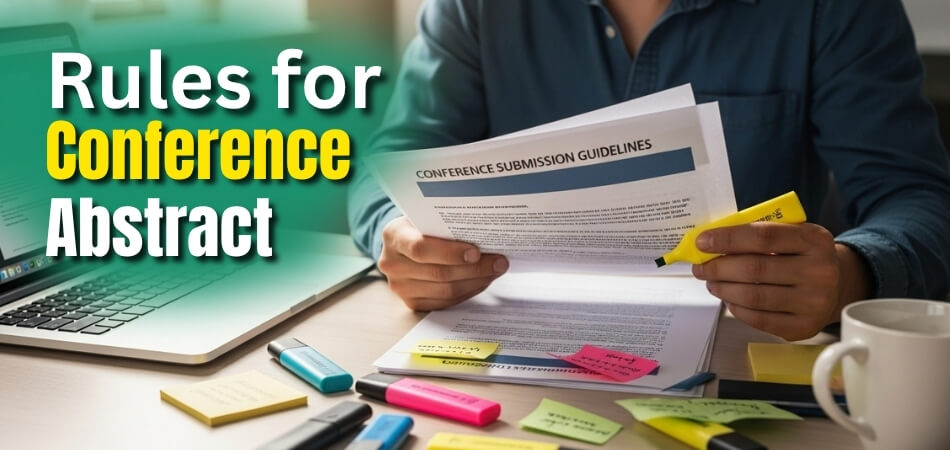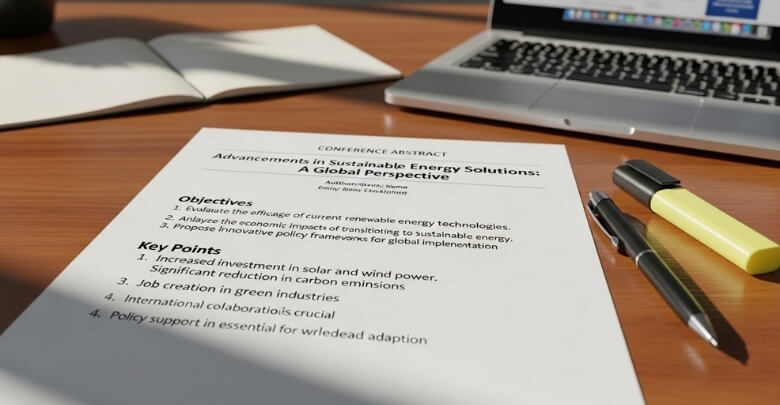Writing a conference abstract is one of the most crucial steps in getting your research noticed. It’s your first opportunity to capture the attention of reviewers and showcase the essence of your study. Many researchers, however, struggle to understand exactly what makes an abstract stand out.
So, what are the rules for conference abstract? In simple terms, these rules are the standards that help you present your research clearly and professionally. They guide you on how to structure, format, and summarize your work so that reviewers can easily understand its purpose, methods, and significance.
Following these rules not only increases your acceptance chances but also reflects your commitment to academic excellence. Keep reading to discover the essential guidelines and practical tips that will help you write a winning conference abstract.
What Are the Rules for Conference Abstract?
Writing a conference abstract is a crucial step toward presenting your research at academic or professional gatherings. It summarizes your study’s purpose, methods, and significance while giving reviewers a clear idea of your contribution. Following these essential rules ensures fairness, readability, and consistency in upcoming conferences in USA, Canada, and across the world.

Define the Purpose Clearly
Your abstract should state what your research is about and why it matters. Begin with a clear objective or research question that guides your work. Reviewers should instantly understand the problem your study addresses and how it contributes to the field of discussion.
Follow the Recommended Structure
Most conferences require a structured format that includes background, objectives, methods, results, and conclusions. This organization helps readers follow your research logically and ensures that key information is presented consistently across all submissions.
Maintain the Required Word Count
Keep your abstract within the given word limit, usually between 200 and 300 words. Staying concise shows discipline and respect for guidelines. Avoid unnecessary details and focus on the most important elements that describe your research effectively.
Use Clear and Formal Language
A professional tone improves readability and credibility. Write in complete sentences, avoid jargon, and make sure your grammar and punctuation are flawless. Clear language ensures your abstract is accessible to both experts and general conference attendees.
Ensure Originality and Relevance
Only submit original work that has not been published elsewhere. Make sure your abstract aligns with the theme or focus area of the conference. Reviewers prefer submissions that contribute fresh perspectives and match the event’s overall objective.
Follow Formatting and Submission Guidelines
Pay attention to specific formatting instructions, including font size, spacing, file type, and submission portal. Adhering to these technical details prevents disqualification and reflects professionalism. Always double-check your abstract before final submission.
Avoid False or Vague Claims
Do not include conclusions or data that haven’t been verified. Instead, use careful phrasing such as “expected outcomes” or “preliminary findings.” This honesty maintains academic integrity and ensures your submission is transparent and trustworthy.
Include Relevant Keywords
Many conferences ask authors to provide 3–5 keywords summarizing their research area. These keywords help organizers categorize your work correctly and improve its visibility among participants interested in similar topics.
By following these eight key rules, your conference abstract will meet professional standards and attract positive attention from reviewers. A well-structured, concise, and original abstract lays the foundation for a successful presentation and helps you make a strong impression in the global research community.
Understanding the Purpose Behind Abstract Guidelines
Every conference has its own abstract guidelines to maintain quality and fairness in the review process. These rules ensure that all submissions follow a similar format, allowing reviewers to compare ideas effectively. Understanding why these guidelines exist helps researchers create abstracts that are not only compliant but also more impactful and engaging.
Abstracts Help Reviewers Understand the Study’s Focus
Conference reviewers receive hundreds of abstracts to evaluate. A well-structured abstract helps them quickly identify your study’s objective, methodology, and relevance. When written clearly, it allows reviewers to assess how well your research fits within the event’s theme and whether it deserves to be included in the presentation lineup.
Clarity, Originality, and Brevity Are Highly Valued
The best abstracts are easy to read, original in thought, and concise in delivery. Reviewers appreciate submissions that communicate ideas efficiently without unnecessary detail. By focusing on clarity and brevity, you make your work easier to understand and increase its chances of being selected among other high-quality submissions.
Ignoring Guidelines Can Lead to Rejection or Delays
Authors who overlook formatting, structure, or word limits often face rejection or requests for resubmission. Even strong research can be dismissed if it fails to meet basic rules. Sticking to guidelines not only shows professionalism but also saves time during the review and acceptance process.
Abstract guidelines are not obstacles but tools for effective communication. They ensure equal treatment for every submission and highlight the value of precision in academic writing. Following them strengthens your credibility and helps your research gain the attention it truly deserves.
Key Components Every Abstract Should Contain
A strong conference abstract follows a clear structure that helps reviewers grasp the essence of your research within a few minutes. Each component plays a specific role in summarizing your work effectively. Understanding and including these parts ensures your abstract meets professional standards and communicates your study with clarity and purpose.
Background or Objective Defines the Purpose
Begin by explaining why the research was conducted. This section should introduce the problem or question your study addresses and highlight its relevance. Clearly stating the objective helps readers understand the motivation behind your work and how it contributes to the broader field of study or real-world issue.
Describe the Process in Methods
The methods section summarizes how the study was performed. It outlines the approach, tools, or data sources used to conduct the research. Keeping this part concise yet specific allows reviewers to evaluate the scientific or analytical soundness of your work without needing to read the full paper.
Results or Expected Findings Present the Outcome
Next, share what your research discovered or what outcomes you anticipate if data collection is ongoing. This section should focus on major findings or trends rather than detailed statistics. Presenting results clearly demonstrates that your study adds meaningful insight or evidence to the topic being explored.
Conclusion or Significance Explains the Impact
Conclude your abstract by summarizing what the results mean and why they matter. Explain how your findings contribute to knowledge, innovation, or practice in your field. A strong conclusion leaves a lasting impression and shows the practical or theoretical importance of your research.
Keywords and Formatting Add Precision
If required, include 3–5 keywords that represent the main themes of your work. They help organizers categorize your abstract correctly. Follow the formatting guidelines given by the conference, such as font size, alignment, and spacing, to maintain a consistent professional appearance.
By including all these components, your abstract will stand out for its clarity, structure, and completeness. Each part works together to tell a clear story of what you studied, how you did it, and why it matters, ensuring your research receives the attention it deserves during review.
Formatting and Submission Rules to Follow
Once your abstract content is ready, the next step is ensuring it meets every formatting and submission requirement. These technical and stylistic rules help maintain uniformity and readability across all submissions. Let’s go through the main rules you must follow before submitting your abstract.
Maintain the Ideal Word Count
Most conferences set a limit between 200 and 300 words for abstracts, which is considered the standard conference abstract length across most academic events. Staying within this range ensures your submission is concise and focused. Writing too little may leave out important details, while exceeding the limit might cause automatic disqualification during the initial review process.
Use Consistent Font, Spacing, and Structure
Follow the specific layout mentioned in the conference guidelines. Common requirements include using a readable font such as Times New Roman or Arial (12 pt), single spacing, and justified alignment. Some events prefer paragraph abstracts, while others require a structured format with labeled sections like “Objective,” “Method,” and “Conclusion.”
Follow Reference and Citation Rules
Many conferences restrict or completely exclude references in abstracts. If citations are allowed, limit them to one or two key sources. Avoid using footnotes or detailed bibliographies. The main focus should remain on your research’s content and clarity rather than external references.
Meet Deadlines and Use Approved File Types
Always submit before the stated deadline using the official submission portal. Late submissions are rarely accepted. Check which file formats are supported—typically PDF, DOC, or an online text form. Ensure your file opens correctly and is named according to the instructions provided by the organizers.
Formatting and submission rules ensure fairness and readability for all participants. By following these guidelines, your abstract not only looks professional but also demonstrates your attention to detail. Proper formatting helps reviewers focus on your ideas rather than technical errors, ultimately improving your chances of selection.
Common Mistakes Authors Should Avoid
Even well-researched studies can be rejected if their abstracts don’t follow proper submission standards. Small mistakes, such as unclear writing or missing details, can make your work seem unpolished. Here are some of the most frequent mistakes that authors should avoid when writing a conference abstract.
Exceeding the Word Limit Reduces Clarity
Going beyond the allowed word count often makes your abstract look disorganized and difficult to read. Reviewers prefer concise submissions that deliver the message clearly within 200–300 words. Respecting the limit shows you understand the importance of focus and discipline in academic communication.
Vague Language and Unproven Claims Lower Credibility
Abstracts filled with general statements or assumptions weaken your work’s impact. Avoid saying things like “this will change the field” without presenting evidence. Use specific terms and measurable observations to maintain credibility. Precise language shows confidence and strengthens your research presentation.
Skipping Proofreading or Ignoring Format Leads to Rejection
Submitting without proofreading or checking format guidelines is a common cause of rejection. Grammar mistakes, inconsistent spacing, or missing sections signal carelessness. Always double-check before submission to ensure every instruction has been followed correctly and that your abstract reads smoothly.
Failing to Match the Conference Theme Hurts Relevance
An abstract that doesn’t align with the conference’s main focus is likely to be overlooked. Read the call for papers carefully and tailor your submission to match its keywords and themes. This alignment helps reviewers recognize the value and relevance of your study.
Quick Reference List of Common Errors
- Writing beyond the 300-word limit.
- Using vague, unclear, or exaggerated language.
- Submitting without proofreading for errors.
- Ignoring formatting rules or submission structure.
- Failing to include relevant keywords or conference themes.
Avoiding these common mistakes ensures your abstract is professional, relevant, and well-received by reviewers. Paying attention to accuracy, structure, and tone reflects your commitment to quality research and helps you stand out in a competitive selection process.
Tips for Writing an Impressive Conference Abstract
If you’re writing your first conference abstract, remember that clarity, confidence, and strategy matter most to make a strong impression on reviewers. It’s not only about summarizing your study but also about presenting it in a way that appeals to reviewers and readers. Applying these simple yet effective writing tips will help you stand out in competitive academic environments.
Use Concise, Clear, and Active Language:
Keep your sentences short and direct. Avoid unnecessary words or complex phrases. Active voice makes your writing sound confident and engaging, allowing reviewers to grasp your research message quickly without confusion or extra explanation.
Write After Finalizing Your Main Paper or Results:
Draft your abstract once your research findings or main conclusions are ready. This ensures that your summary reflects accurate information and provides a complete picture of your study’s purpose, process, and outcomes.
Ask a Mentor to Review Before Submission:
Having a second opinion can reveal errors or unclear points you may have missed. Peer feedback improves the structure, tone, and readability of your abstract, helping you submit a polished and professional version.
Adjust Each Abstract to the Specific Conference’s Focus:
Customize your writing based on the conference theme and audience. Using relevant keywords and emphasizing applicable results makes your abstract more appealing to reviewers and increases the likelihood of selection.
A well-crafted abstract is your opportunity to make a lasting first impression. By keeping it clear, concise, and relevant, you increase your chances of acceptance and recognition. Write with confidence and submit knowing your work represents your best effort.
Frequently Asked Questions
Curious about the finer details of writing and submitting a conference abstract? Here are some common questions researchers often ask after learning the main guidelines. These answers will help you strengthen your submission and clear up any confusion before sending it for review.
Can I Submit the Same Abstract to Multiple Conferences?
Submitting the same abstract to different conferences is usually discouraged unless stated otherwise. Many organizers prefer original submissions. Always review each event’s policy carefully to avoid potential disqualification or ethical issues during the review process.
Should I Include Tables, Charts, or Figures in My Abstract?
Most conferences don’t allow visuals in abstracts since space is limited. Instead, describe your data briefly using text. If the event permits figures or charts, ensure they are clear, properly labeled, and relevant to the main topic.
How Important Is the Abstract Title?
Your title is the first thing reviewers and attendees notice. It should be short, precise, and reflect your study’s focus. Avoid overly complex words. A clear and specific title improves visibility in the conference booklet and digital platforms.
Can I Edit My Abstract After Submission?
Some conferences allow minor edits before the final deadline, while others lock submissions immediately. Always double-check your abstract for errors before submitting. If changes are urgent, contact the organizing committee directly for approval.
Do I Need to Mention Funding or Sponsorship in the Abstract?
If your research was funded or supported by an organization, include a short acknowledgment at the end of your abstract. It adds transparency and credibility while showing appreciation for the support received.
How Do Reviewers Evaluate Abstracts?
Reviewers typically assess clarity, originality, and relevance. They check if your abstract follows the format, fits the conference theme, and demonstrates academic or professional value. Meeting all these expectations greatly improves your acceptance chances.
What Happens After My Abstract Is Accepted?
Once accepted, you’ll usually receive an invitation to present your work at the conference, either orally or as a poster. You may also need to prepare a full paper or presentation slides based on the event’s requirements.
Concluding Words
Understanding what are the rules for conference abstracts is the first step toward creating a strong and successful submission. These rules guide you in presenting your research clearly, ensuring that your ideas are understood and valued by both reviewers and readers.
By following the right structure, maintaining the word limit, and focusing on clarity, your abstract can leave a lasting impression. It shows professionalism, organization, and respect for academic standards, all of which increase your chances of acceptance.
Writing an abstract may seem challenging at first, but with practice and attention to detail, it becomes easier. Apply these guidelines carefully, and you’ll be well-prepared to share your research confidently at future conferences.







